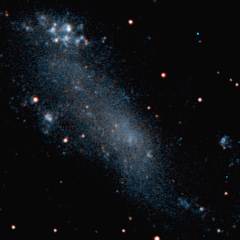What a fine image!

IC 2574 is the galaxy that I call "The Jumping Pig". The picture on the left shows the jumping pigginess of the galaxy pretty well. You can see how the pig is making a mighty jump towards the upper left. At top left you can see the profile of the pig, looking left, with its snout open. You can see its ears, too. Its front legs is at center left.
Yes, but with better and better photography it's getting ever harder to spot the pig in the Jumping Pig Galaxy! But while Stephen Leshin has mislaid the pig, he has brought out many other details in this porcine galaxy. For example, just as it is in the story about the Three Little Pigs, IC 2574 is a
little galaxy. Even though there are still massively starforming large galaxies around today like M101 and M99, much of the star formation in the present-day universe is taking place in small galaxies. That's because the large galaxies have converted so much of their gas into stars already, and then they have massive black holes and large-scale interactions that tend to stir up the remaining gas and heat it so that it is no good for making stars any more.
Small galaxies usually have no central black holes, or at least no really large ones. (There may be exceptions.) Of course, small galaxies can turn off their own star formation by other means.
A strong burst of star formation in a small galaxy will produce a batch of massive stars, which will then explode as supernovae. These tremendous explosions will expel a lot of gas from the small galaxies, whose puny gravity is not up to the task of reining in the lost gas again. And when the gas has been lost, the galaxies are "barren". That's probably the main reason why there are so many small, faint, lenticular galaxies with no trace of star formation in them. They succumbed to their own past glory!
By the way, I cheated when I posted this second galaxy picture, because it is actually a dwarf irregular galaxy, which means that it probably has some star formation. The truly "red and dead" dwarf galaxies are so boring that there seems to be no pictures of them! (Okay, I take that back: there
are pictures of "dead" dwarf galaxies, such as
this NASA/ESA image of the Antlia dwarf galaxy.)
Anyway, if we return to today's APOD, we may note a few interesting details about it. First, most of the star formation is concentrated in one relatively small part of the galaxy. That is typical even of true "starburst" galaxies - the starburst is taking place in one or a few small parts of the galaxy.
Second, most of the rest of the star formation is taking place on the periphery of the visual disk of the galaxy. The center is running out of fresh gas and star formation.This is interestingly similar to large spiral galaxies, whose central parts are usually crammed with old yellow stars, and here there is often little or no star formation. But farther out from the center, in the spiral arms, many new stars are often being born.
There is a central blue blob (filled with smaller blue blobs) in IC 2574, and there is even a hint of pink in it. Nevertheless, it is clear that this is a site of past star formation. Interestingly, this could be the center of IC 2574. If this galaxy ever develops a central black hole, it will likely be located here!
The entire central part of IC 2574 shows signs of relatively recent star formation. There are many bluish stars here, but few pink emission nebulae. If IC 2574 ever grows into a large galaxy (which I find most unlikely), this inner blue area will turn into a yellow bulge.
Note that there is a "neutral-colored" population of stars between the inner blue central part and the brilliantly starforming periphery. This neutral-colored population is undoubtedly made up of old stars.
All in all, this brilliant Little Pig galaxy is like a sparkler in the night. Originally made up of gas, it has set fire to much of itself, turning itself into brilliant stars and nebulae. But soon the most massive of the stars it has given birth to will immolate themselves in tremendous explosions and take much of the Little Pig's gas with it out into the stellar night.
And then everything in the Little Pig will be still, dim, and silent.
Ann
 IC 2574: Coddington's Nebula
IC 2574: Coddington's Nebula

